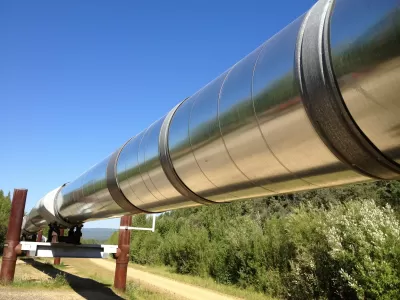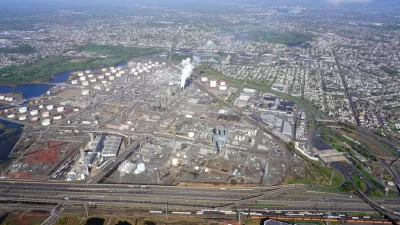The Federal Energy Regulatory Commission (FERC) flies under the radar, but it makes some of the most consequential decisions about the federal government's approach to climate change.

David Roberts interviews Richard Glick, commissioner of the Federal Energy Regulatory Commission (FERC), and Matthew Christiansen, a FERC advisor, to discover more about the powers of the little-known branch of the U.S. government to sway federal climate change policy.
"FERC sits at the heart of the clean energy transition, overseeing two key areas of frequent conflict," explains Roberts to introduce the interview. "The first is bulk electricity — interstate transmission lines and regional wholesale power markets. The second is natural gas infrastructure; the agency licenses the siting and building of all new pipelines."
The interview ranges from a discussion about the success of FERC's climate change efforts so far (on pipelines, Glick says FERC is doing poorly), how FERC might expand its abilities to address climate change, the uneasy relationship between FERC and states, the regulation of distributed power, and more.
For more details on the subjects covered in the interview, and more, see also an article written by Rich Glick and Matthew Christiansen for theEnergy Law Review.
FULL STORY: This federal agency is quietly, profoundly shaping climate policy

Planetizen Federal Action Tracker
A weekly monitor of how Trump’s orders and actions are impacting planners and planning in America.

Restaurant Patios Were a Pandemic Win — Why Were They so Hard to Keep?
Social distancing requirements and changes in travel patterns prompted cities to pilot new uses for street and sidewalk space. Then it got complicated.

Map: Where Senate Republicans Want to Sell Your Public Lands
For public land advocates, the Senate Republicans’ proposal to sell millions of acres of public land in the West is “the biggest fight of their careers.”

Maui's Vacation Rental Debate Turns Ugly
Verbal attacks, misinformation campaigns and fistfights plague a high-stakes debate to convert thousands of vacation rentals into long-term housing.

San Francisco Suspends Traffic Calming Amidst Record Deaths
Citing “a challenging fiscal landscape,” the city will cease the program on the heels of 42 traffic deaths, including 24 pedestrians.

California Homeless Arrests, Citations Spike After Ruling
An investigation reveals that anti-homeless actions increased up to 500% after Grants Pass v. Johnson — even in cities claiming no policy change.
Urban Design for Planners 1: Software Tools
This six-course series explores essential urban design concepts using open source software and equips planners with the tools they need to participate fully in the urban design process.
Planning for Universal Design
Learn the tools for implementing Universal Design in planning regulations.
Heyer Gruel & Associates PA
JM Goldson LLC
Custer County Colorado
City of Camden Redevelopment Agency
City of Astoria
Transportation Research & Education Center (TREC) at Portland State University
Camden Redevelopment Agency
City of Claremont
Municipality of Princeton (NJ)





























